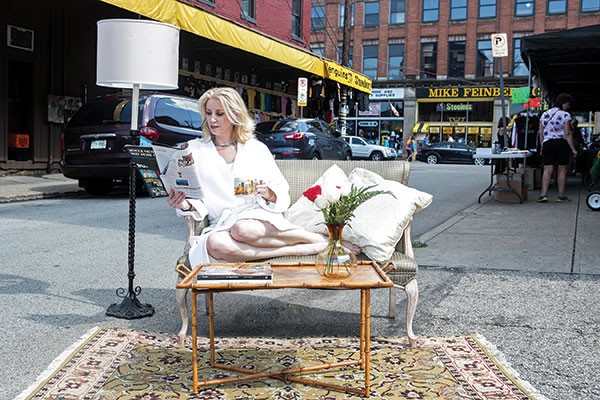Take a stroll down Penn Avenue in the Strip District and you get the sense of a neighborhood stuck in time. Vendors and shops line the streets much like they have for the past 50 years, selling produce, fresh seafood, Steelers memorabilia and more.
But as you venture onto Penn's parallel streets closer to the river, you can't help but notice things are changing. Here, tractor trailers on their way to and from Smallman Street's produce warehouses dodge pedestrians navigating narrow, fragmented sidewalks, and residents walk their dogs along railroad tracks lined with upscale restaurants.
The influx of residents calling the Strip District home marks yet another shift in the neighborhood's history — and that increase in residents is set to skyrocket.
Over the next few years, the Strip District could welcome as many as 1,400 residential units, as at least seven developers vie to rehabilitate dilapidated factories and vacant lots. But they could have an unforeseen impact on the neighborhood's diversity, nighttime economy and overall identity.
"The challenges are to keep the Strip District real and authentic," says Daniel Rothschild, president of Rothschild Doyno Collaborative, an architecture and urban-design firm in the Strip District. "It's one of the most vibrant shopping districts we have and has that old-world feeling that most cities covet. So the challenge for us is to make sure we don't disturb that."
According to a 2002 report by students at the University of Pittsburgh, there were an estimated 266 residents living in the Strip District in 2000. (The population was nearly the same in 1990, at 275.) A decade later, that number has ballooned to more than 600, according to the most recent U.S. Census data and that figure could triple after proposed developments are completed.
Residential developments in the neighborhood began to pick up steam in 2007, when the 400-unit Cork Factory building opened. Shortly after, the Otto Milk condos followed suit with 82 units.
Like these developments, the residential units in the works will cater to residents with higher incomes than those traditionally found in the Strip. Before 2000, three quarters of the 58 families living in the neighborhood made less than $25,000 a year.
]
Today, with one-bedroom condos in the Otto Milk Building selling for almost $300,000, the median income in the neighborhood is also rising. From 1999 to 2009, the median household income in the Strip District rose from $55,000 to $75,000, according to census data.
While Becky Rodgers, executive director of community organization Neighbors in the Strip, is a proponent of residential development in the neighborhood, she worries the pending residential projects will have a negative impact on economic diversity.
"We're very supportive of residential development, especially when it's rehabbing old buildings," Rodgers says. "But I would love to see more diversity in the price of housing."
Among the projects currently under construction are 11 homes priced at $1 million or more. And while price details for the other projects aren't known, Rodgers says she anticipates they will similarly be luxury housing and worries that high rents will exclude young professionals. Rents at the Cork Factory range from $1,500 to $4,000. Rodgers would like to see rents as low as $750.
"What can we do to get the government to do that? Even if it's a small percentage of the housing being built," Rodgers says. "I know the developers are doing it to make money. I know money is tight for all government agencies, but it seems to me there has to be a way everyone gives a little to keep the diversity."
In order to maintain the Strip's diversity, state Sen. Wayne Fontana says Neighbors in the Strip should look at what residents have done to fight for affordable housing in the lower Hill District development. In residential projects that use public subsidies, community groups can require developers to set aside a number of affordable housing units.
"That's something that needs to be considered," Fontana says.
Rothschild agreed saying, "One only need to look at the lower Hill District to see the importance of the community voicing their interest in maintaining diversity through affordable housing."
The Urban Redevelopment Authority and city planning department did not respond to requests for comment. However, of the seven residential projects in the works, only one includes a request for public funds.
So far at least, residential developments have attracted a somewhat diverse population that also includes young professionals.
"I like that you can walk to pretty much everything you need, and you are still very close to Downtown amenities, but you don't have to pay quite as much as apartments that are right Downtown," says 29-year-old Amanda Roll, who lives in the Cork Factory.














